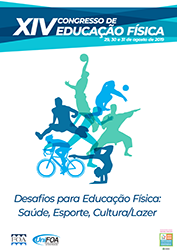A pandemia do sedentarismo
uma perspectiva de futuro
Palavras-chave:
Atividade física, Sedentarismo, SaúdeResumo
Os possíveis benefícios da Atividade Física são conhecidos desde muito tempo. Textos antigos já exibem a ideia de promover a saúde através do movimento. No entanto, no decorrer dos anos, o modo como as pessoas trabalham e vivem sofre mudanças e com isso vem incorporando cada vez menos movimento em seu cotidiano. Morris e Paffenbarger foram dois autores que influenciaram a forma como a Atividade Física era vista e como o movimento era importante para a saúde. Órgãos internacionais publicaram diversas recomendações de atividades físicas e ainda assim a inatividade física atualmente é considerada uma pandemia. Tendo tudo isso em mente a questão é: Quais são os fatores que influenciam na escolha das pessoas em se ter uma vida ativa, em optarem pelo movimento seja no trabalho, no tempo de lazer, no transporte para o trabalho, para casa, enfim, para que tenham uma vida mais ativa?
Referências
CLARK, Jocalyn. Mark Stevenson: systems thinker for cities. The Lancet, v. 388, n.10062, p. 2863, 2016.
DAVISON, Kirsten K.; WERDER, Jessica L.; LAWSON, Catherine T. Peer reviewed: Children’s active commuting to school: Current knowledge and future directions. Preventing chronic disease, v. 5, n. 3, 2008.
DE BLASIO, Bill. Healthier neighbourhoods through healthier parks. Lancet (London,England), v. 388, n. 10062, p. 2850, 2016.
GILES-CORTI, Billie et al. City planning and population health: a global challenge. The lancet, v. 388, n. 10062, p. 2912-2924, 2016.
GOENKA, Shifalika; ANDERSEN, Lars Bo. Urban design and transport to promote healthy lives. The Lancet, v. 388, n. 10062, p. 2851-2853, 2016.
GOROBETS, Alexander. Development of bicycle infrastructure for health and sustainability. Lancet, v. 388, n. 1278, p. 31671-3, 2016.
KLEINERT, Sabine; HORTON, Richard. Urban design: an important future force for health and wellbeing. The lancet, v. 388, n. 10062, p. 2848-2850, 2016.
KOHL 3RD, Harold W. et al. The pandemic of physical inactivity: global action for public health. The lancet, v. 380, n. 9838, p. 294-305, 2012.
LAROUCHE, Richard et al. Active transportation and adolescents’ health: the Canadian Health Measures Survey. American journal of preventive medicine, v. 46, n.5, p. 507-515, 2014.
LARSEN, Kristian et al. The influence of the physical environment and sociodemographic characteristics on children's mode of travel to and from school. American Journal of Public Health, v. 99, n. 3, p. 520-526, 2009.
LEE, I.-Min (Ed.). Epidemiologic methods in physical activity studies. Oxford University Press, 2008.
LEE, I.-Min et al. Effect of physical inactivity on major non-communicable diseases worldwide: an analysis of burden of disease and life expectancy. The lancet, v. 380, n. 9838, p. 219-229, 2012.
LIMA, Alex Vieira; RECH, Cassiano Ricardo; REIS, Rodrigo Siqueira. Equivalência semântica, de itens e conceitual da versão brasileira do Neighborhood Environment Walkability Scale for Youth (NEWS-Y). Cadernos de Saúde Pública, v. 29, p. 2547-2553, 2013.
LIMA, Dartel Ferrari de; LEVY, Renata Bertazzi; LUIZ, Olinda do Carmo.Recomendações para atividade física e saúde: consensos, controvérsias e ambiguidades. Revista Panamericana de Salud Pública, v. 36, p. 164-170, 2014.
MCDONALD, Noreen C. Active transportation to school: trends among US schoolchildren, 1969–2001. American journal of preventive medicine, v. 32, n. 6, p.509-516, 2007.
MORRIS, J. N.; RAFFLE, P. A. B. Coronary heart disease in transport workers. A progress report. British Journal of Industrial Medicine, v. 11, n. 4, p. 260, 1954.
MCGUIRE, Darren K. et al. A 30-year follow-up of the Dallas Bed Rest and Training Study: II. Effect of age on cardiovascular adaptation to exercise training. Circulation,v. 104, n. 12, p. 1358-1366, 2001.
PATE, Russell R. et al. Physical activity and public health: a recommendation from the Centers for Disease Control and Prevention and the American College of Sports Medicine. Jama, v. 273, n. 5, p. 402-407, 1995.
REIS, Rodrigo S. et al. Scaling up physical activity interventions worldwide: stepping up to larger and smarter approaches to get people moving. The lancet, v. 388, n.10051, p. 1337-1348, 2016.
SALLIS(a), James F. et al. Physical activity in relation to urban environments in 14 cities worldwide: a cross-sectional study. The Lancet, v. 387, n. 10034, p. 2207-2217,2016.
SALLIS(b), James F. et al. Use of science to guide city planning policy and practice: how to achieve healthy and sustainable future cities. The lancet, v. 388, n. 10062, p.2936-2947, 2016.
SALLIS, James F. et al. An ecological approach to creating active living communities. Annu Rev Public Health, v. 27, p. 297-322, 2006.
STEVENSON, Mark et al. Land use, transport, and population health: estimating the health benefits of compact cities. The lancet, v. 388, n. 10062, p. 2925-2935, 2016.
WONG, Bonny Yee-Man; FAULKNER, Guy; BULIUNG, Ron. GIS measured environmental correlates of active school transport: a systematic review of 14 studies. International journal of behavioral nutrition and physical activity, v. 8, n. 1, p.39, 2011.
WORLD HEALTH ORGANIZATION et al. Global action plan for the prevention and control of noncommunicable diseases 2013-2020. 2013.
Downloads
Publicado
Edição
Seção
Licença
Copyright (c) 2019 Congresso de Educação Física de Volta Redonda

Este trabalho está licenciado sob uma licença Creative Commons Attribution-NonCommercial-ShareAlike 4.0 International License.

